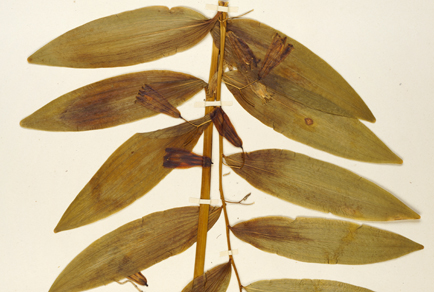Abstract
The genus Polygonatum Miller (1754: without page) consists of perennial herbs, distributed in the temperate Northern hemisphere (POWO 2024). It is well appreciated in East Asia for its wide array of commercial uses and the species diversity (Kim et al. 2014, Floden 2017). Despite the increased recognition of its value as a natural resource, knowledge of the taxonomy and phylogenetic relationship among congeners has been lacking (Floden 2014, Chao & Tseng 2019). There are unresolved nomenclatural problems (Floden & Schilling 2018), in Polygonatum, around 340 binomials for 76 accepted species (IPNI 2024, POWO 2024, WFO 2024) have been published since Miller (1754), hence often the taxonomic identity of the many species is not straightforward and always in the flux.
References
- Chao, C.-T. & Tseng, Y.-H. (2019) Revision of Polygonatum (Asparagaceae, Nolinoideae, Polygonateae) of Taiwan. Phytokeys 117: 99–118. https://doi.org/10.3897/phytokeys.117.31902
- Chen, X. & Tamura, M.N. (2000) Polygonatum. In: Wu, Z.Y. & Raven, P.H. (Eds.) Flora of China, vol. 24. Science Press, Beijing, and Missouri Botanical Garden Press, St. Louis, pp. 223–232.
- Floden, A. (2014) A new combination in Polygonatum (Asparagaceae) and the reinstatement of P. mengtzense. Annales Botanici Fennici 51: 106–116. https://doi.org/10.5735/085.051.0115
- Floden, A. (2017) Molecular phylogenetic studies of the genera of tribe Polygonateae (Asparagaceae: Nolinoideae): Disporopsis, Heteropolygonatum, and Polygonatum. Ph.D dissertation, University of Tennessee, Knoxville.
- Floden, A. & Schilling, E.E. (2018) Using phylogenomics to reconstruct phylogenetic relationships within tribe Polygonateae (Asparagaceae), with a special focus on Polygonatum. Molecular Phylogenetics and Evolution 129: 202–213. https://doi.org/10.1016/j.ympev.2018.08.017
- Hara, H. (1944) Polygonatum eupolygonatum in Nippon. Journal of Japanese Botany 20: 94–102.
- Hooker, J.D. (1894) The Flora of British India, vol. 6. L. Reeve and Co., London, 792 pp.
- IPNI (2024) International Plant Names Index. Published on the Internet. The Royal Botanic Gardens, Kew, Harvard University Herbaria & Libraries and Australian National Botanic Gardens. Available from: http://www.ipni.org (accessed 29 January 2024)
- Kim, J.H., Seo, J.W., Byeon, J.H., Ahn, Y.S., Cha, S.W. & Cho, J.H. (2014) Morphological characteristics and phylogenetic analysis of Polygonatum species based on chloroplast DNA sequences. Korean Journal of Medicinal Crop Science 22: 489–496. https://doi.org/10.7783/KJMCS.2014.22.6.489
- Koidzumi, G. (1919) Contributiones ad Floram Asiae Orientalis. Botanical Magazine Tokyo 33: 110–122. https://doi.org/10.15281/jplantres1887.33.396_217
- Maximowicz, C.J. (1883) Diagnoses plantarum Novarum asiaticarum V. Mélanges biologiques tirés du Bulletin de l’Académie impériale des sciences de St. Pétersbourg 11: 623–876.
- Miller, P. (1754) The Gardeners Dictionary, Abridged, fourth edition, vol. 3. John and James Rivington, London, 584 pp.
- POWO (2024) Plants of the World Online. Facilitated by the Royal Botanic Gardens, Kew. Published on the Internet. Available from: http://www.plantsoftheworldonline.org/ (accessed 29 January 2024)
- Royle, J.F. (1839) Illustrations of the botany and other branches of the natural history of the Himalayan Mountains:and of the flora of Cashmere. Vol. 1. Wm. Allen and Co., London, 472 pp. https://doi.org/10.5962/bhl.title.449
- Tamura, M.N. (2008) Biosystematic studies on the genus Polygonatum (Asparagaceae) V. Taxonomic revision of species in Japan. Acta Phytotaxonomica et Geobotanica 59: 15–29.
- Tropicos (2024) Tropicos, Missouri Botanical Garden. Available from: https://tropicos.org (accessed 29 January 2024)
- Turland, N.J., Wiersema, J.H., Barrie, F.R., Greuter, W., Hawksworth, D.L., Herendeen, P.S., Knapp, S., Kusber, W.-H., Li, D.-Z., Marhold, K., May, T.W., McNeill, J., Monro, A.M., Prado, J., Price, M.J. & Smith, G.F. (Eds.) (2018) International Code of Nomenclature for algae, fungi, and plants (Shenzhen Code) adopted by the Nineteenth International Botanical Congress Shenzhen, China, July 2017. Regnum Vegetabile 159. Koeltz Botanical Books, Glashütten. https://doi.org/10.12705/Code.2018
- Wallich, N. (1820) Descriptions of some rare Indian plants. Asiatic Researhes 13: 369–415.
- Wallich, N. (1831) A Numerical List of dried specimens of plants in the East India Company's Museum: collected under the superintendence of Dr. Wallich of the Company's botanic garden at Calcutta. London.


